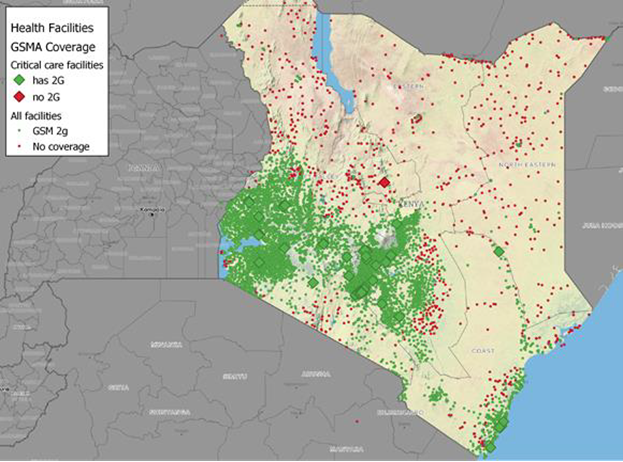 Photo: © SolarAid
Photo: © SolarAid
Health is an essential component of human capital formation, especially in the early years of the lifecycle. Despite recent progress made, the quality of health services in Kenya remains insufficient. Poor availability and quality of infrastructure is one factor, among others, that affect the provision of healthcare services. Patients need good roads to access health facilities or cell-phone coverage to call for help.
In addition, proper roads are needed for staff and medicines to reach the facilities on time, electricity to ensure the functioning of medical fridges to store vaccines, as well as phone and internet coverage for medical staff to access information and improve their supply chain management.
While the impact of poor roads limiting access to health services on health outcomes has been studied in Kenya, Mozambique, and India, among other countries, more remains to be explored on the impact of infrastructure -or the lack of it- on the supply of health services and its quality.
To improve our understanding of this issue, a recent joint research paper from the World Bank Infrastructure and Human Development Chief Economist Offices – “Infrastructure matters: Complementarities with the quality of health service delivery in Kenya” – explores the links between infrastructure and the provision of health services.
What do we know about access to infrastructure at health care facilities in Kenya?
The paper combines geospatial data on the location of health facilities, local economic characteristics, and access to infrastructure with the World Bank’s Service Delivery Indicators (SDI) survey, an exhaustive health facility survey which covers a nationally representative subset of facilities for 2018. According to the SDI survey, only 56% of primary-level health care facilities have access to stable electricity and only 15% of health facilities use ICT for supply chain management.
In order to complement the survey questions related to infrastructure, the paper uses multiple sources of geospatial data on infrastructure to extensively evaluate access to roads, electricity, and internet coverage for each health facility. The detailed road quality data shows that health facilities are on average 2 km away from the nearest road of at least fair quality, with a large variation from 0 to 95 km. Figures 1, 2, and 3 show the spatially uneven access of facilities to electricity, internet infrastructure proxied by the 2G coverage, and road quality.
Figure 1: Access to electricity for health facilities using the Global Electrification Platform

Figure 2: Access to 2G coverage

Figure 3: Proximity to fair- or good-quality primary or secondary roads for health facilities

Note: The maps show connectivity status for all facilities as listed and referenced in the Master List.
Source: Global Electrification Platform and GSMA, Kenya Road Fund 2018.
To what extent has improved access to infrastructure been associated with higher quality of health services?
The paper considers four dimensions to evaluate the quality of health services: diagnostic accuracy as a proxy for the quality of provider knowledge, the availability of vaccines, the availability of medicines, and the availability of Ante-Natal Care Tests.
-
First, being closer to fair or good quality roads and having access to electricity are associated with more accurate provider diagnostics, not only for general illnesses (diarrhea with dehydration, pneumonia, diabetes, and tuberculosis), but also for illnesses affecting primarily children and threatening the life of pregnant women (diarrhea with dehydration, pneumonia, post-partum hemorrhage, and neonatal asphyxia). We find that the diagnostic accuracy is 5 percentage points lower in the health facilities that are further from at least fair quality road (fourth quartile of distance) – compared to the facilities that are closer (first quartile of distance)
-
Second, access to stable electricity is associated with 10 percentage points higher availability of Vitamin A and vaccines for children, partially by making possible to have a working fridge, which is essential to store most vaccines (i.e., Rubella, Polio (OPV/IPV), Rotavirus, Pentavalent, Pneumonia, and Bacille Calmette-Guerin (BCG)).
-
Third, a greater proximity to fair or good quality roads, as well as access to reliable electricity, which also increases the use of ICT for supply chain management, are associated with higher availability of essential and priority medicines. Access to good quality roads, a stable connection to the electricity, and ICT use for supply management are related to an increase of, respectively, 2.9, 4.5 and 6.8 percentage points in availability of medicines.
-
Fourth, being closer to fair or good quality roads, access to stable electricity, and use of ICT for supply management are positively related to the availability of tests for pregnant women (tests for HIV, Urinalysis, Hemoglobin, and Syphilis). Stable electricity service raises the provision of such tests by 5.6 percentage points. The use of ICT for supply management by 2. Percentage points, and farther distance from good quality roads decreases it by 2.5 percentage points.
In conclusion – while the absence of time series data does not allow for rigorous determination of causality – there is certainly strong suggestive evidence that infrastructure may play an important role in improving the quality of health service provision, including the services for early childhood and maternal health. The implication is that efforts to improve access to roads, electricity and internet could make an important contribution to the quantity and quality of health service delivery across the whole of Kenya. This indicates the importance that infrastructure expansion programs explicitly aim to cover health facilities, and that health service enhancement programs integrate measures to upgrade infrastructure access.
________________
#Infra4Dev is a blog series that showcases recent World Bank economic research to explore how Infrastructure is critical for development. You can access to all the previous Infra4Dev blogs here.





Join the Conversation